Our research found that Asana is a better overall project management software solution than Wrike. The tool provides an easier to use interface and better customer support options, making it a far better solution for small businesses that may not be familiar with this kind of technology.
Wrike is far from a poor choice, though. It offers more complex task management features like user hierarchy, which makes it an ideal tool for larger businesses that may be looking to scale in the near future. It’s also worth noting that both Wrike and Asana offer free forever plans, but they are otherwise on the more expensive end of the project management software spectrum.
In this comparison guide, you’ll learn about the key difference between Wrike and Asana, including how much they cost, how the interfaces differ, and what kind of features you can expect when using one of these two popular project management tools.
| Price from All prices listed as per user, per month (billed annually) | Score The overall score obtained from our most recent round of project management software user testing | Free version | Pros | Cons | Verdict | |||
|---|---|---|---|---|---|---|---|---|
| 4.5 | 4.4 | |||||||
| | | |||||||
|
| |||||||
|
| |||||||
| A simple task-list-based project management platform with an acceptable free tier | A feature-rich service with two plans for enterprises, and a free tier for new users to try | |||||||
| Compare Deals | Visit Wrike |
Asana vs Wrike: Which Is Best?
Deciding on which is best between Wrike and Asana really comes down to the needs of your company or team. Asana is a better choice than Wrike for individuals and small teams, but Wrike has the edge over Asana if you need a project management tool for a large team or business.
Here are some of the key differences between Asana and Wrike to help you decide which one is best for your business.
- Asana offers an easier to use interface than Wrike.
- Wrike offers more complex hierarchy features for large teams than Asana.
- Asana has better customer support options than Wrike
- Wrike and Asana offer top tier security protocols
- Both Wrike and Asana offer free forever plans and virtually identical pricing
Test Summary
As project management software providers go, these two products are pretty similar. Both Asana and Wrike use the same basic idea of a left-rail, double-pane primary interface, although Asana’s will take you less time to get used to.
I found setting up with Wrike was pretty speedy, like it was with Asana. But when I started needing to use Wrike’s more advanced features, like the automation builder, I started to run into dead ends. Although Asana’s interface felt a little cramped when we used it to manage tasks, it felt a lot less complex than Wrike’s – it also automatically suggested things like task dependencies, which is quite unique and something I found pretty useful.
However, Wrike and Asana are on the pricier end of the market, and I don’t think they’ll be as good value for money for small businesses when providers like Teamwork have paid plans available for $5.99 per user, per month. Teamwork’s interface is extremely similar to Asana’s but it feels like it’s made with beginners in mind – the automation builder is a lot easier to use, as is the software more broadly.

Asana vs Wrike: Head-to-Head
Below, there is a short review of both Wrike and Asana, but we’ve got individual sections for things like business features and customer support further down in this article. here’s a rundown of the sections:
Best value: Tie
Arguably one of the most important metrics to consider when it comes to installing new software is how much value you’re getting for the price you’re paying, and how many features you can obtain for the lowest price. After assessing Wrike and Asana’s pricing plans, we found that they are strikingly similar, with both offer a free forever plan and some less-than-competitive paid plans.
The starting price plan for Asana, for example, is $10.99 per user, per month, while it’s only $10 per user, per month with Wrike, both of which are high compared to other options in the industry, like Zoho Projects at only $4 per user, per month.
The next plan from each platform is also quite similar, with Asana offering a plan for $24.99 per user, per month and Wrike offering one for $24.80 per user, per month. These are pretty expensive, too, with monday.com offering two other paid plans for less than either at $12 per user, per month and $18 per user, per month, respectively.
On top of that, both Asana and Wrike offer two enterprise plans that provide custom pricing for users, so you’ll have to reach out to the provider to find out how much these plans will cost.

We loved Wrike’s Calendar view, which is available on the Team plan. Image: Tech.co testing.
Best for ease of use: Asana
Both of these providers were among the easier-to-use pieces of software – they’re notably less complicated than options like Smartsheet in our research, thanks to their simple, easy to understand interfaces.
However, it was the functionality of Wrike’s more advanced features that let it down. For instance, several members of our group tried to build some mock automations during testing and didn’t find it very straightforward. “I’d used a custom column earlier on, which created a limitation when I wanted to use automations” explains Alice Martin, who participated in our most recent user testing series. “It didn’t seem to recognize the purpose of my tags,” she added.
There were a couple of other issues with Wrike. “I started to add in tasks and I thought there was an autosave,” said Tech.co’s Insights Manager Natasha Willet, referencing how most project management tools will automatically save your work when you’re inputting task information. “In fact, there wasn’t no auto-save, but everything I had input within the first five minutes just disappeared.”
Asana, on the other hand, makes it easier to hop between views than Wrike, auto-populates your dashboard view with project data, and even makes smart suggestions about tasks you should be linking together. Its interface will initially feel a little cramped when you open a task to edit it, but you definitely get used to it.

The Wrike Kanban board made is easy to track all the information we needed. Image: Tech.co testing
If your team isn’t that computer savvy at all, you’ll be better off with monday.com than Asana or Wrike. Its clever use of white space and minimalistic approach to the layout of the interface will instantly make you feel more organized, while many of the advanced features are intended to be more intuitive. I was also personally impressed with monday.com’s responsive live chat function, which I used to connect to agents and troubleshoot a number of issues.
Best for business features: Asana
Both Wrike and Asana scored highly for features in our research, a criteria made up of four sub-categories; task management, workflow creation, data visualization, and collaboration.
When it comes to workflow creation, Asana rules the roost, thanks to one of the better automation builders we tested. It is incredibly straightforward and easy to use, and there are quite a few competitors (like ClickUp) that, while being great programs, make this function overly complicated.
Task management, on the other hand, is a far better experience when carried out with Wrike, thanks to a spreadsheet-style view with formulas, which Asana does not offer. However, Asana has a broad range of task management features, which helped it net the win in this category.
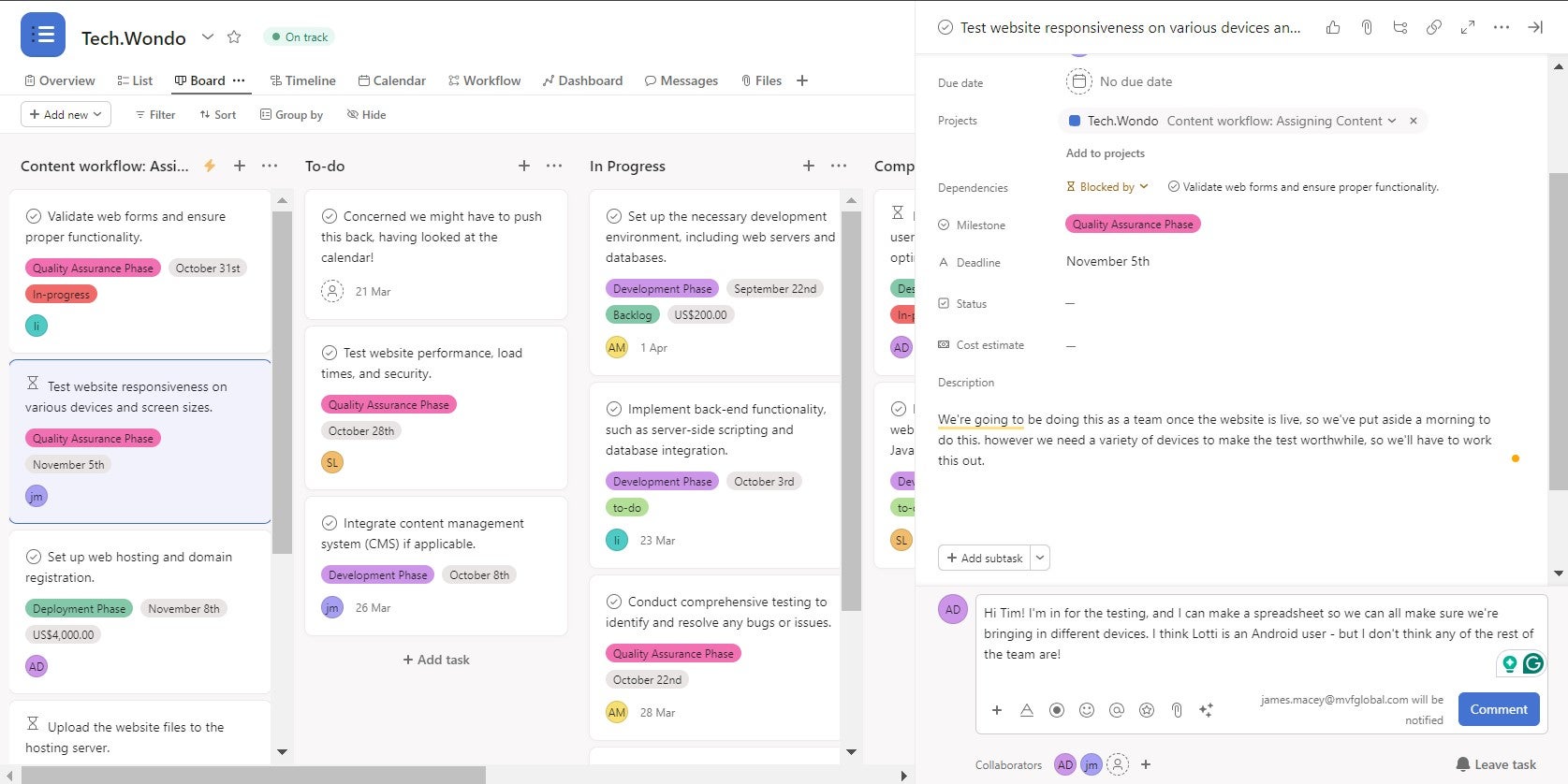
Commenting on a task in Asana to ensure my team is informed and up-to-date. Image: Tech.co testing
In terms of data visualization, Asana wins again. It’s fair to say Asana has the best data dashboard that we saw during testing, making it incredibly easy to glean insights into your team and how they’re working. Also, you can build your own charts from scratch, but you can’t do that in Wrike.
However, it’s worth noting that neither Wrike nor Asana includes any of their tools on their free plans. ClickUp, which scored the same as Asana on our latest tests, offers a dashboard, as well as preset and custom widgets, on its free plan.
When it comes to collaboration, Wrike and Asana don’t offer much to write home about. You’ll be able to comment on tasks and post on a project message board, but aside from that, they’re pretty bare. There’s no online whiteboard like the one offered by ClickUp, and neither provides a document editing function like monday.com.
Best for customer support: Asana
Asana has better customer support than Wrike, but only just. Asana edges it largely due to the fact that live chat help is available on every plan, including the free plan.
Live chat is a really important support option to have because most of the issues you’re going to run into on a daily basis aren’t going to be major, project-defining problems – so it’s useful to have someone on hand to correct your course if there’s a small technical hiccup.
Asana also offers 2/47 live support on its enterprise plan – which Wrike doesn’t provide for free (you can get a Support Package for 24/7 support but it costs extra). Both providers offer onboarding assistance on their paid plans, however.
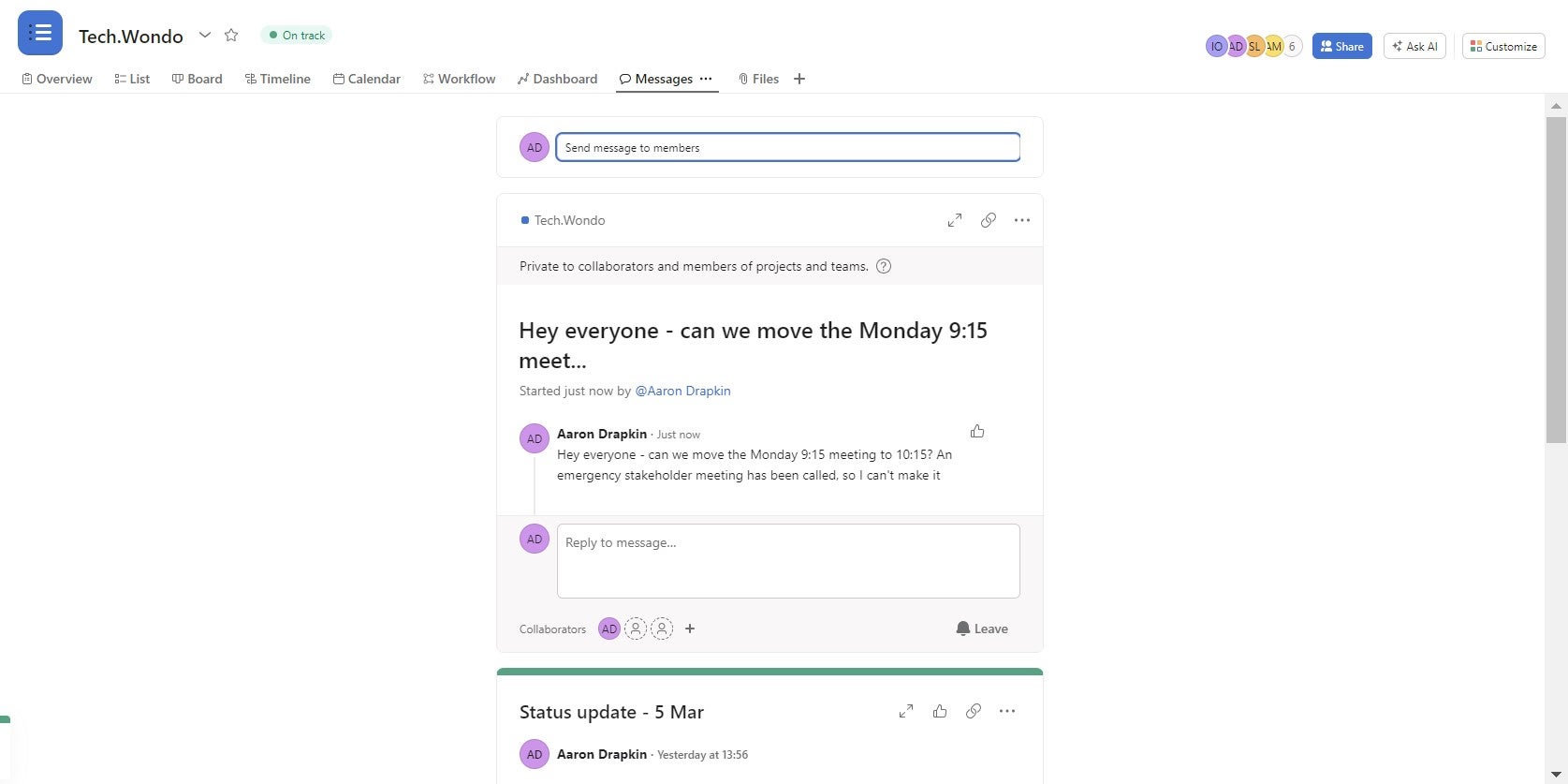
Leaving a message on Asana’s project message board. Image: Tech.co testing
Best for integrations: Wrike
A good project management system will do a lot more than just manage projects, which is where third party integrations come in handy. Both Wrike and Asana offer app libraries that can help you build out the overall functionality of the platforms, adding scalability to both options.
However, a quick look at Wrike’s and Asana’s respectively app libraries and it’s clear that Wrike offers more to choose from. You’ll find approximately 400 different integrations with Wrike, while Asana only offers around 200 integrations.
Both offer the main ones, though, so there’s a good chance you’ll be all set no matter which one you choose. Wrike and Asana both offer integrations with Microsoft Teams, Salesforce, Google, Adobe, Tableau, Jira, and hundreds more.
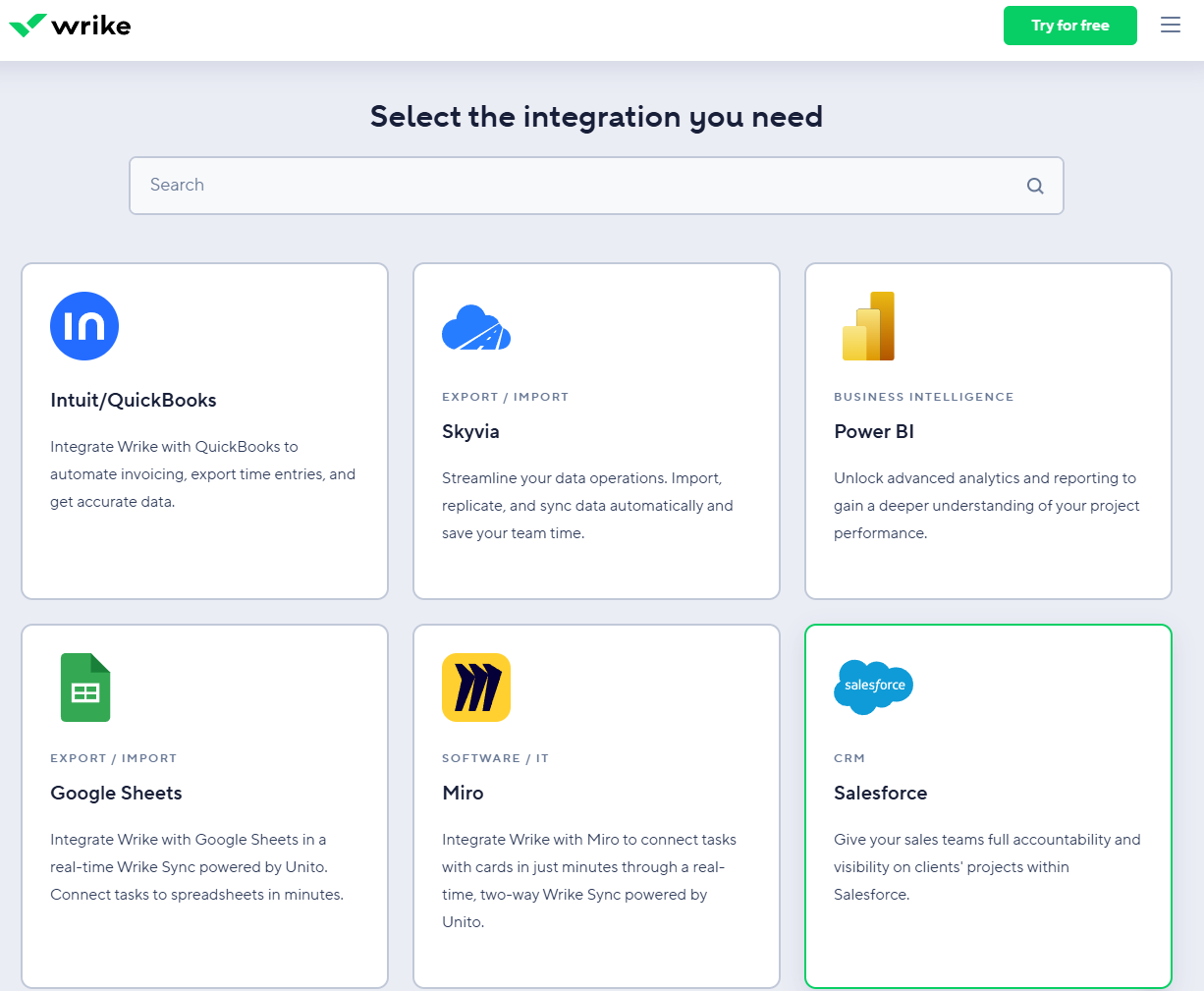



Wrike offers slightly more apps in its library than Asana. Image: Tech.co testing
Best for security: Tie
If your business deals with a lot of sensitive data, whether it be medical information or just confidential sales numbers, you’re likely concerned about how well Asana and Wrike can protect your information.
Luckily, both Asana and Wrike offer some robust security protocols to ensure you won’t suffer a breach. Both Asana and Wrike use Transport Layer Security (TLS) 1.2 with a preferred AES 256 bit algorithm for encryption, and both offer features like two-factory authentication and regular backups to make sure you are secure at all times.
Asana vs Wrike: Team Sizes
Asana and Wrike are both very respectable options when it comes to project management software. The most important way to identify which project management tool one might be better for you and your business is the size of your team.
We break down the differences with a few helpful comparisons below, but you can also use our free comparison tool to see how the two compare against other providers.
Asana is better than Wrike for individual projects
Asana is a great option for individual projects or for freelancers looking to keep their work in order. Most people should be able to get by with the free tier, Asana Basic. This tier doesn’t include sub-tasks or dependencies, but as long as you can do without those features, Basic should be all you need.
The Basic plan’s essential features include task creation (naturally), as well as list view, board view, and calendar view. Basic supports up to 15 team members, compared to Wrike’s five, meaning you can invite collaborators as needed. Basic also lets you assign tasks to others when you’re collaborating.
However, we’d recommend Teamwork’s free plan over Wrike and Asana for individuals – it has a three-person user limit, but it’s got more task management features, five different project templates and you’ll be able to access phone-based support. It’s also easier to use, we found, as completing basic project management tasks during setup was slightly smoother. Both providers have quite a similar layout, but Asana’s felt marginally more cluttered.
For anyone who needs more than that, it’ll cost $10.99 per user, per month to move up to Premium. This tier is where the feature set really explodes, offering milestones, dependencies, subtasks, timelines, and advanced reporting. With so much functionality on offer, we found it to be overkill for any single-person projects.
Why Asana is better for individual projects:
- Asana Basic (free tier) is likely to be enough for most single users
- It supports up to 15 collaborators
- Going beyond the free tier is overkill for most individuals
- Offers more users than Wrike’s free tier, as well as user permissions, two-factor authentication, and a calendar
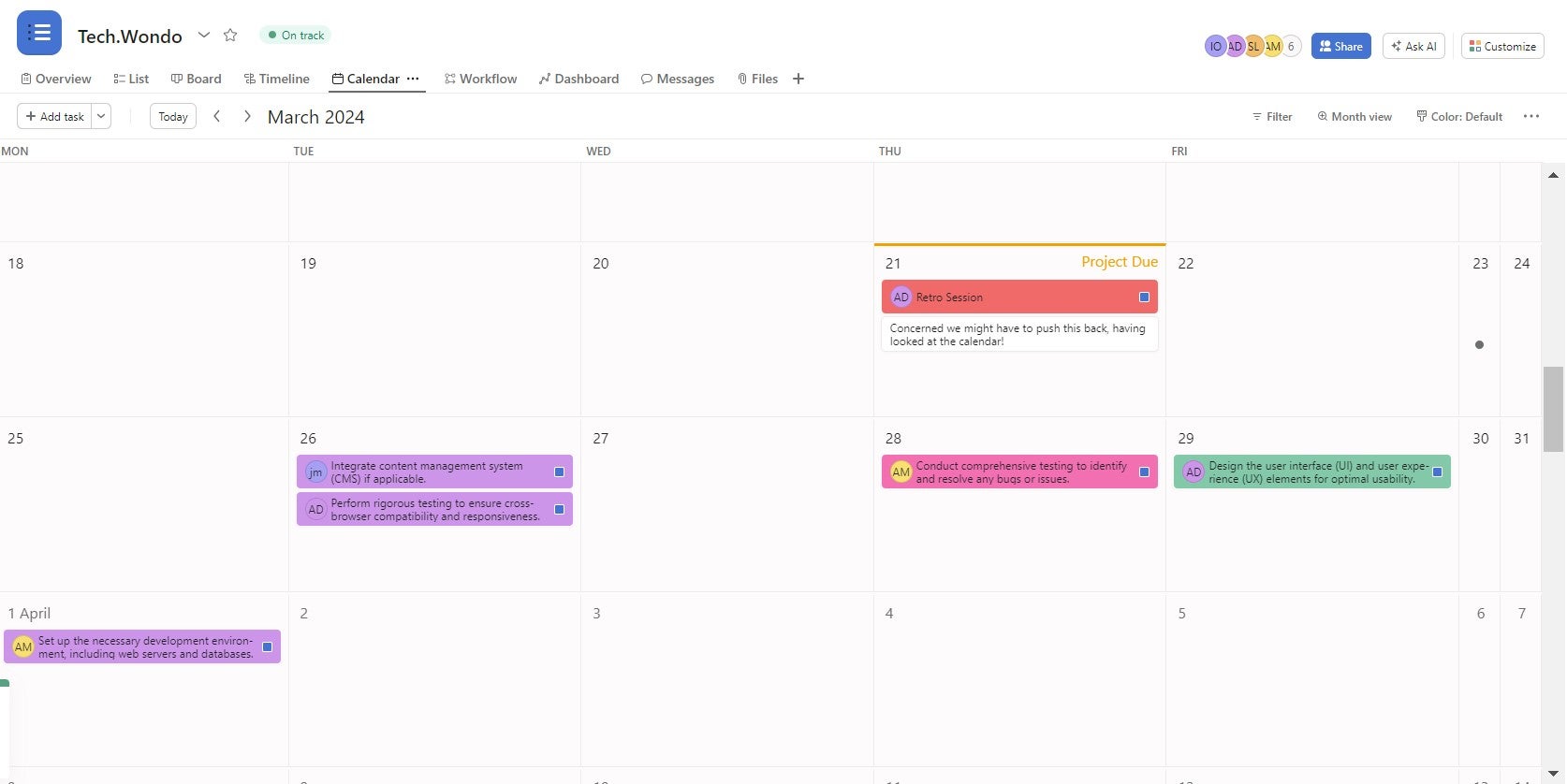
Using Asana’s calendar view to view my project tasks. Image: Tech.co testing
Asana is better than Wrike for small teams and businesses
Although this is a head-to-head comparison of Asana vs Wrike, it’s safe to say both providers will satisfy the needs of small businesses, despite Asana marginally having the edge. They both score well for task management, customer support, security, and integrations, but Asana provides access to more features, on cheaper plans.
If you’re a small business with very little budget to spend on project management software, then you’ll be wanting as much bang for your buck as you can get. Asana’s cheapest paid plan edges Wrike’s cheapest paid plan, with a calendar, custom, and preset charts, custom fields, and unlimited storage, all of which Wrike doesn’t provide. Overall, it’s a better value-for-money plan despite being $1.19 more expensive per user, per month.
Another reason Asana is better for small businesses is onboarding assistance, which is available on all plans but the free plan. This will be particularly useful for your small business if you don’t have an IT team or simply the time to teach staff the ins and outs of a new software program. Along with the live chat function we discussed earlier, this helped Asana to a high score for customer support.
However, Wrike is better for small marketing teams thanks to an array of marketing features and integrations included on the Business plan. As well as this, as we’ve covered, Wrike is slightly more usable, particularly for managing ongoing projects. If the $24.80 per user, per month Business Plan is within your budget, you’ll have one of the best sets of task management features currently available, and features like file and video proofing which will be useful for marketing campaigns.
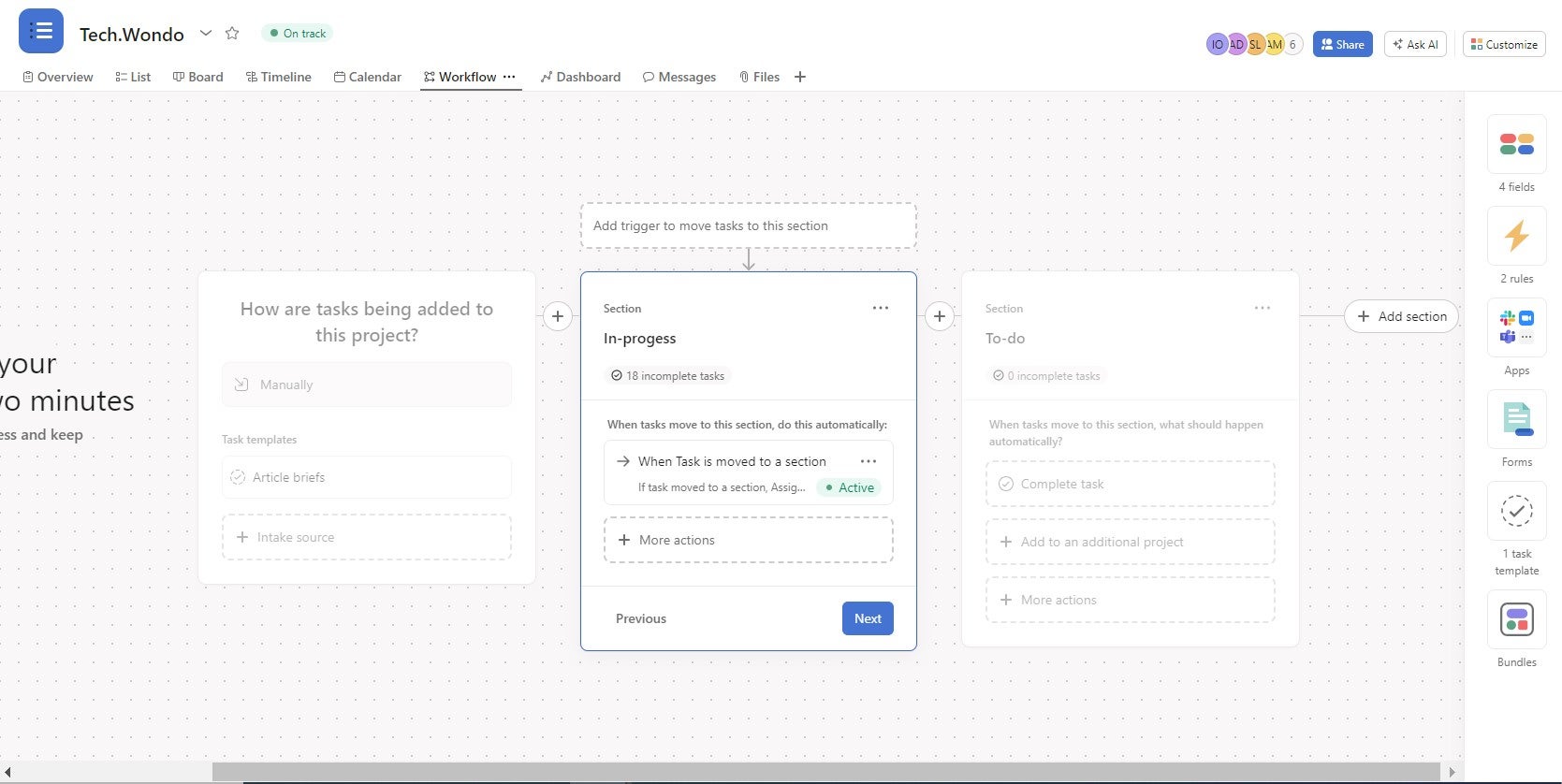
Asana’s Workflow menu, where you can build automations. Image: Tech.co testing
Wrike is better than Asana for mid-sized teams
When your team starts to grow to a certain size, keeping your data organized so things run smoothly becomes even more important. Wrike offers a good way to do this with its folder structure. Many project management services offer a project, and then lists of tasks under that. Some of these apps allow you to create lists to better organize your tasks.
None, however, allow as much depth of organization as Wrike, with its ability to create folders and sub-folders within a project. That may be too much organization for some teams, but for those who need to keep an unruly project (or projects) on track, those folders are a big help. There’s also built-in time tracking for the Business tier and higher, as well as 5GB of storage per user.
Another plus for mid-sized businesses is that Wrike provides a comparative overview of each team member’s resource, including week-by-week and month-by-month breakdowns. You can also use the Gantt chart to view tasks by team members.
Wrike will also let you assign budgets to individual tasks, whereas some project management tools will only let you assign one for a whole project. These features helped Wrike to a test-high for task management, along with easy-to-use classics like a Kanban board, Gantt chart and standard table view.
Wrike is better for large/multiple teams
Wrike doesn’t mess around when it comes to adding features that large companies and enterprises will benefit from. Wrike comes with the usual features, such as SAML 2.0 for single sign-on management, password policies, and two-factor authentication on all plans.
It can also integrate with many business intelligence tools via the company’s application programming interface for moving data. There’s also a built-in integration tool for Tableau, a popular data management service, and a huge range of marketing and financial integrations, making Wrike ideal for scaling businesses that want to add functionality. If you’re using a web of apps and you want to centralize your data around one place, Wrike is a good option.
Other key features for enterprises include network access and compliance policies to restrict Wrike to whitelisted IP addresses, which is an option on Wrike’s Enterprise and Pinnacle plans, but isn’t available on any Asana plan. There are also “advanced user access controls” for controlling inheritance permissions on folders and sub-folders, as well as access reports to see who can get into all the various company projects.
What’s more, Wrike’s Business tier ($24.80 per user, per month) is a couple of cents cheaper than Asana’s equivalent Business tier ($24.99 per user per month) while also including time tracking and the potential for CRM functionality.
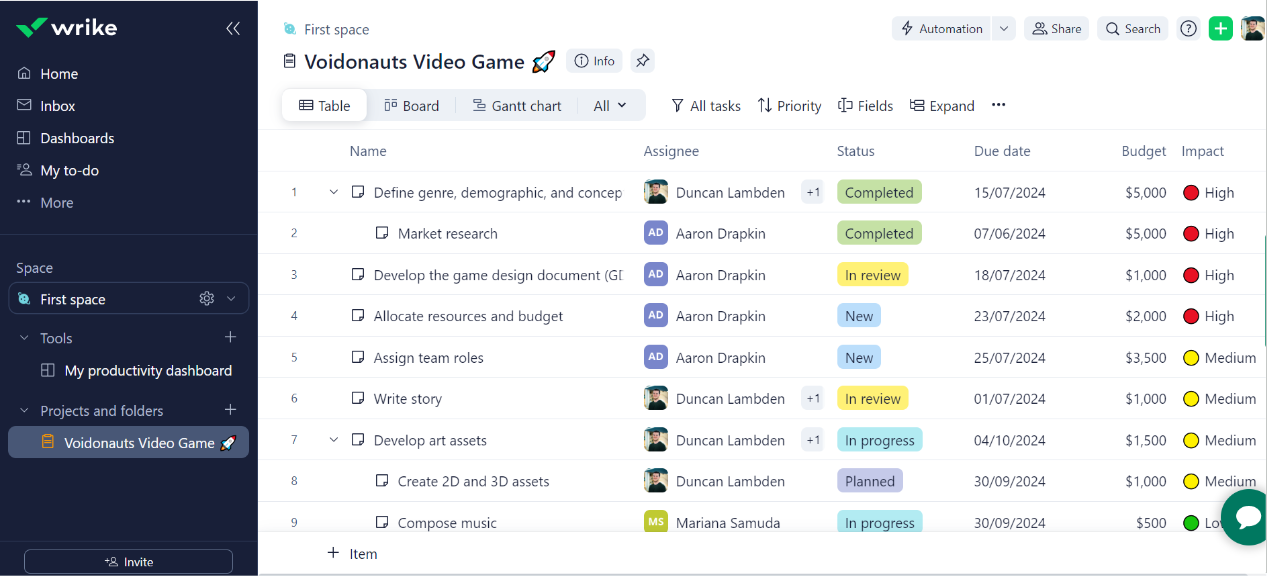











Wrike’s Table and Calendar view, Analytics dashboard, and its automation builder. Images: Tech.co’s testing process
Asana Pricing vs Wrike Pricing
Arguably one of the most important metrics to consider when it comes to installing a new software at your business, pricing comparisons between Asana and Wrike can be incredibly helpful. Use our free comparison tool to see how the two stack up against other providers, or see a quick breakdown of both pricing plans below.
Wrike Pricing
Wrike has five tiers. The three publicly priced tiers are the Free plan, the Professional plan ($10 per user per month), and the Business plan ($24.80 per user per month). There’s also Pinnacle and Enterprise plans with custom pricing you’ll have to contact sales for.
| Price (annually) The amount you'll pay per month, when billed annually | Users | Projects/boards | Automations | Gantt chart | Resource management | Time tracking | ||
|---|---|---|---|---|---|---|---|---|
| TRY IT FOR FREE | ||||||||
| Unlimited | 2 – 15 | 5-200 | 5-Unlimited | 5-Unlimited | ||||
| Unlimited | Unlimited | Unlimited | Unlimited | Unlimited | ||||
| N/A | 50/user/month | 200/user/month | 1,000/user/month | 1,500/user/month | ||||
| | | | | | ||||
| | | | | | ||||
| | | | | |
Asana Pricing
Asana has three payment plans, as well as two bespoke plans where the price depends on the limits and options you include. Their three payment plans are the Free plan, the Premium plan ($10.99 per user per month), and the Business plan ($24.99 per user per month).
| Price (annually) The amount you'll pay per month, when billed annually | Users | Projects/boards | Automations | Gantt chart | Resource management | Time tracking | ||
|---|---|---|---|---|---|---|---|---|
| TRY IT FOR FREE | ||||||||
| 2 | Unlimited | Unlimited | Unlimited | Unlimited | ||||
| Unlimited | Unlimited | Unlimited | Unlimited | Unlimited | ||||
| N/A | Unlimited | Unlimited | Unlimited | Unlimited | ||||
| | | | | | ||||
| | | | | | ||||
| | | | | |
Wrike Review Summary
If you compare Wrike to other project management services, you’ll notice its more conservative interface and approach. For example, Wrike uses a folder hierarchy by default, although you can opt to ignore this uncommon approach and use a Kanban-style board instead. There is also a spreadsheet-like view, rather like you’ll get with Microsoft Project.
For those who like a well-organized hierarchy of tasks, Wrike is the ideal choice – but a well-structured way to keep your data sorted isn’t all it has to offer. For example, Wrike provides you with multiple customizable calendars, which can be assigned to individual projects, teams, or even a specific folder.
For those who like a well-organized hierarchy of tasks, Wrike is the ideal choice.
Check out our in-depth guide to Wrike pricing for more information
Another great feature is document history, which is available for files you upload to Wrike. It requires Wrike’s desktop plugin, but once that’s up and running, you can make changes to a document and view past versions in a single location. Document versioning is a must-have feature for any company, and while you can find it in online services such as Google Docs, it’s nice that Wrike offers it as part of a project management tool.
Wrike also beats Asana in spreadsheet functionality, as Wrike provides “formula” columns, which enable automatic calculations. Asana has no such feature.
Features
- Built-in time tracking
- Multiple views, including spreadsheet
- Customizable calendars
- Generative AI
- Unlimited custom fields
- Gantt charts, Calendar & Chart view

Pros
- No-nonsense, robust feature catalog
- Lots of customizability
- Strong task management and data tools
- Huge integrations library
Cons
- Not entirely easy to use
- Difficult to use automation builder
- Not the best for collaboration
- Free plan available

- Team: $10/user/month

- Business: $25/user/month

Asana Review Summary
Asana is a popular option for project management for a number of reasons. It has a great interface and offers all the key features required for basic project management in its two lower tiers. Tasks, subtasks, dependencies, and milestones are all available with Asana Premium. There’s also a timeline as part of Premium for those who need it.
Asana’s project templates are also helpful if you’re just getting started with project management. The idea is to create the bare bones of a basic project, and then have the team fill in the rest. Asana’s basic templates include a cross-functional template for projects that involve team members from different departments. There’s also a template for marketing, product launches, and many other options. There are a number of templates available at the free tier, with other options only available for Premium subscribers and upwards.
Asana’s project templates are helpful if you’re just getting started with project management.
Check out our in-depth guide to Asana pricing for more information
For those with larger teams, Asana offers a number of solid options to keep projects on track. These include Portfolios, which offer an overview of all team projects and their current state. Workload complements this by providing a look at each team member’s workload, to help better manage the team’s overall effectiveness.
Looking at ways where Asana specifically beats Wrike, Asana comes out on top in both its forms and its automation builder. While Wrike has a form builder, Asana’s is a lot more streamlined and easy to use. The same applies to their automation builders as well. Wrike does have one, but it’s hidden away and also much harder to use. Asana’s is once again smoother and more streamlined.
Features
- 100+ third party integrations
- Portfolios and Workload features
- Useful project templates
- Asana AI features for all paid plans
- 256-bit encryption at rest and in transit
- Workflow builder for automation

Pros
- Unlimited storage
- Plenty of third-party integrations
- Incredibly clean and intuitive interface
- Easy-to-use dashboards and chart builder
Cons
- Most key features require an Advanced plan
- Very high prices for larger teams
- No phone-based support
- Free plan available

- Starter: $10.99/user/month

- Advanced: $24.99/user/month

- Enterprise: Custom pricing

At Tech.co we don’t write about products and services without conducting thorough research, and hands-on testing where applicable. While this process can be time consuming, it’s time well spent if it means we’re providing better, more useful information for your business.
When it comes to project management software, we test out each program first-hand, guided by an in-house research framework consisting of six core assessment areas that break down into a range of smaller subcategories. This framework is based on the factors companies and project managers have told us are important to their everyday usage. The six criteria are:
- Ease of use: After getting five to six participants to test each project management software for an hour, we assessed how easy it was to set up a project with the platforms, how clear their interfaces were, and how easy they were to navigate.
- Pricing: We look at all plan costs. Providers offering lots of features for lower costs will have better pricing scores than those that lock them away on higher-tier plans.
- Customer support: We assess the ways you can contact your project management software provider if something goes wrong. Providers offering 24/7 live support, as well as phone-based support and onboarding assistance, get the best scores.
- Security: For this area, we assess the security options offered by each provider. This includes user-level security features like two-factor authentication, as well as more administrative security measures like user permissions and IP restrictions.
- Integrations: We assess the quantity — and the quality — of the applications each project management software provider integrates with.
- Functionality: This part of our research involves assessing the full feature set that each product provides. We look at four function-based sub-categories as part of this, including task management, project and workflow creation, data visualization, and collaboration.
It’s important to note that not all of these criteria hold equal weight in our testing methodology. This is best practice and based on what businesses have told us is essential, compared with what’s simply “nice to have”.
Because of their central importance to project management, how easy each tool is to use, how much it costs, features for project and workflow creation, and task management had more of an impact overall than other criteria.
Asana vs Wrike: The Verdict
In the battle of Wrike vs Asana, it’s clear that Asana is better if you’re part of a smaller business, and narrowly beat Wrike. Asana has better customer support options, a better automation builder, and a better dashboard feature for displaying project data. Overall, you’ll find it easier to set up and quicker to get to grips with, if your experience is anything like our ease-of-use tests.
For complex projects involving a myriad of tasks, teams, and members, Wrike may be a better shout. It’s a little harder to use and the automation builder is clunky, but it has a much higher task management score than Asana and is more capable of complex project management and tracking employee capacity.
Wrike also offers IP restriction capabilities on its Enterprise and Pinnacle plans while Asana doesn’t offer this at all. These small differences make Wrike the better option for larger businesses.
If you click on, sign up to a service through, or make a purchase through the links on our site, or use our quotes tool to receive custom pricing for your business needs, we may earn a referral fee from the supplier(s) of the technology you’re interested in. This helps Tech.co to provide free information and reviews, and carries no additional cost to you. Most importantly, it doesn’t affect our editorial impartiality. Ratings and rankings on Tech.co cannot be bought. Our reviews are based on objective research analysis. Rare exceptions to this will be marked clearly as a ‘sponsored’ table column, or explained by a full advertising disclosure on the page, in place of this one. Click to return to top of page



